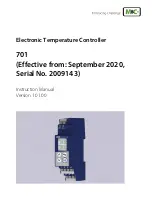
MIC 1400 Manual
Edition 1
10
2.2.1.2 AC POWER WIRING
Neutral (For 115 VAC)
It is good practice to assure that the AC neutral is at or near ground poten-
tial. To verify this, a voltmeter check between neutral and ground should be
done. On the AC range, the reading should not be more than 50 millivolts.
If it is greater than this amount, the secondary of this AC transformer sup-
plying the instrument should be checked by an electrician. A proper neutral
will help ensure maximum performance from the instrument.
2.2.1.3 WIRE ISOLATION
Four voltage levels of input and output wiring may be used with the unit:
• Analog input or output (i.e. thermocouple, RTD, VDC, mVDC, or mADC)
• SPDT Relays
• SSR driver outputs
• AC power
The only wires that should run together are those of the same category. If
they need to be run parallel with any of the other lines, maintain a minimum
6 inch space between the wires. If wires must cross each other, do so at
90 degrees. This will minimize the contact with each other and reduces
“cross talk”. “Cross Talk” is due to the EMF (Electro Magnetic Flux) emitted
by a wire as current passes through it. This EMF can be picked up by
other wires running in the same bundle or conduit.
In applications where a High Voltage Transformer is used (i.e. ignition sys-
tems) the secondary of the transformer should be isolated from all other
cables.
This instrument has been designed to operate in noisy environments, how-
ever, in some cases even with proper wiring it may be necessary to sup-
press the noise at its source.
2.2.1.4 USE OF SHIELDED CABLE
Shielded cable helps eliminate electrical noise being induced on the wires.
All analog signals should be run with shielded cable. Connection lead
length should be kept as short as possible, keeping the wires protected by
the shielding. The shield should be grounded at one end only. The pre-
ferred grounding location is the sensor, transmitter or transducer.











































